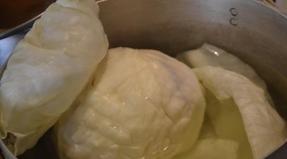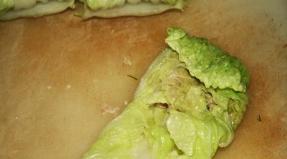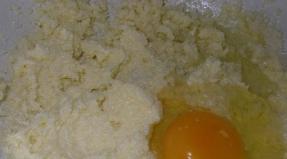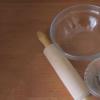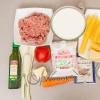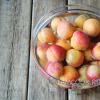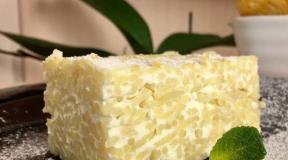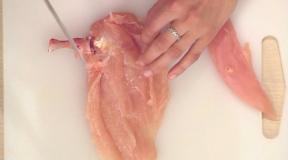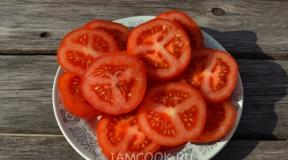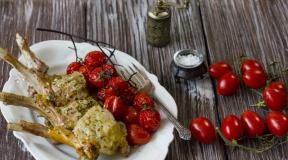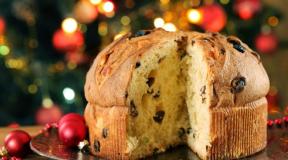Easter cake: a classic recipe and delicious variations. Easter cake with nuts and raisins - video recipe
Classic Easter cake (translated from Greek as “bread of a round or oval shape”) - yeast rich product, baked in the form of a tall cylinder and decorated with icing or powdered sugar. Recipes Easter bread there is a great variety: varying degrees of sweetness, on milk, kefir, cream, sour cream, with all kinds of additives, spices and spices.
Despite the richness of variations, the basic and basic is Easter cake on dough, with two batches and dough proofing. It's about this, classic way cooking and will be discussed today. The article will be especially useful for those who bake Easter cakes on their own for the first time - a recipe with detailed photos and cooking details will help you achieve excellent results the first time. Baking will turn out soft and airy, porous and light. The technology and quantity of ingredients have been tested repeatedly - this is the most delicious recipe Easter cake from “ordinary” ones (there are “unusual” ones, for example, on sourdough) that I have tried.
Total cooking time: 3 hours / 40 minutes / Yield: 2 kg
Ingredients
for steam:
- milk - 500 ml
- pressed yeast - 50 g
- sugar or vanilla sugar- 2 tbsp. l.
- wheat flour - 5 tbsp. l.
for the test:
- opara - all
- whole eggs - 4 pcs.
- yolks - 2 pcs.
- wheat flour - 1 kg
- salt - 1/3 tsp
- butter - 200 g
- sugar - 2 tbsp.
- duchesse essence - 2 ml optional
- raisins, dried apricots or candied fruits - 100 g
In addition, you will need:
- icing and sugar sprinkles for decoration
Cooking a classic Easter cake
The first stage is the preparation of the dough. I heat up 0.5 liters of milk in a saucepan or microwave oven down to about 35 degrees. I breed yeast in warm milk, kneading them with my hands. I add 5 tablespoons of sifted flour and 2 tablespoons of sugar - you can use regular granulated sugar or vanilla sugar (you will need two packs of 10 g each, then the essence is not needed). I mix with a whisk, cover with a towel and put in a warm place without drafts.

After 30 minutes, the dough will rise with a high cap, increase by 2 times. Depending on the room temperature, it may take a little longer, up to 40 minutes.

In a deep bowl I combine eggs (4 whole + 2 yolks, large eggs), as well as sugar, salt and butter. I beat everything with a mixer until fluffy. It is better to soften the butter before room temperature. If there is no time, then you can heat it in a water bath or in the microwave, and then cool it to room temperature.

The result is a fluffy mass with small patches of butter. Add 2 cups of sifted flour and beat again with a mixer. If there is no special technique, then proceed with the old proven method, mix everything manually with a whisk.

I combine the egg-butter-flour mixture and dough. Gently, very gently mix with a spoon from top to bottom (do not use a mixer!).

I introduce the remaining flour, sifting it through a sieve. I knead the dough with my hands for 10 minutes. As much as you'd like to add more flour, you can't! The dough will turn out sticky, very viscous, like honey. That's the way it should be. Therefore, I recommend initially weighing 1 kilogram of flour and removing the excess in the farthest corner, away from temptation. I pour the kneaded dough into large saucepan or into a deep kneading basin (volume 10 l), lubricated with vegetable oil.

I cover with a towel and put in heat. After 1 hour the dough Easter cakes will do and will increase by about 2 times.

I add the Duchess essence (2 ml, half a large bottle, about 20 drops), add candied fruit. If you used vanilla sugar for the dough, then, of course, you do not need to add the essence. Instead of candied fruits, you can take traditional raisins and dried apricots, previously steamed, dried and rolled in flour. I knead the dough so that the candied fruits and essence are evenly distributed, the kneading is short, 1-2 minutes. I put it back in heat for 1 hour.

After the second approach, I knead the dough for the last time and lay it out in forms. To "pacify" sticky dough, it is better to scoop it up with hands dipped in vegetable oil. I fill about 1/3 of the volume, I also correct the caps with a hand dipped in oil so that they turn out to be even, without tubercles. I put the forms for proofing, that is, in a warm place without drafts, for 30-40 minutes.

After the specified time, the dough will rise 2 times, which means that it is time to send the forms to the preheated (!) oven. I bake at 180 degrees. For the first 20 minutes, the oven door must not be opened. Large cakes will be ready in 40 minutes, small ones in about 30 minutes. I always check readiness with a wooden skewer. If the top is browning too much, you can cover with foil. Ready Easter cakes I cool, be sure to lay them on their side, since the crumb is very tender, like a panettone.

On the break you can clearly see how soft and airy the crumb is, like a cloud.

I cover completely cooled and strengthened Easter cakes with icing and decorate with sugar sprinkles. From the indicated amount of ingredients, a large yield is obtained, the total weight is 2 kilograms (I got 10 Easter cakes different sizes plus another baking sheet of mini-cakes in muffin tins). The amount of ingredients is easily divided into two, so you can safely take half the portion.

Easter cakes are perfectly stored and do not get stale for a week. Happy Easter! Christ is Risen!

Let's prepare products for the classic Easter cake.
Let's take warm milk and add yeast. Our dough will be heavy, because the recipe uses a lot of butter and sugar. Therefore, I take 1.5 packs, that is, somewhere around 12 g. Let the yeast disperse slightly.



Add the rest of the flour and knead the dough. More flour may be needed. But don't beat the dough too hard.

We put the dough for 2 hours in a warm place. It shouldn't rise too much.

Knead the dough for the classic Easter cake again, divide it into two parts, you can also into 4.

I took paper form and silicone. We put the dough in the mold and let it stand for another 1 hour.

Once the dough has risen, place it in the preheated oven. We bake at 180 degrees, 30 minutes until a dry splinter.

Ready classic cake pour glaze. For glaze, beat egg whites well and add powdered sugar.

I congratulate everyone on the upcoming holiday!

Bon appetit!
Alenkiy
Have you decided to bake Easter cakes for Easter, but do not know which cake recipe to choose? We looked into the network, and there is such an abundance a variety of recipes that the eyes ran? How to understand which cake recipe is right? The answer is simple: in modern Orthodox cuisine classic recipe Easter cake is distinguished by dough rich in buns, seasoned with dried fruits and raisins. Baking is eggs, butter, sugar, fat sour cream or cream. If you see in the recipe that at least five eggs (or yolks, when they want to achieve special softness of the text) and a pack of butter are taken per kilogram of flour, then this is a traditional Easter cake. The classic recipe also calls for the dough to rise several times. To put it simply: they kneaded the dough, put it in heat, it rose, kneaded it, set it to rise again and did the same thing two or three more times. This technology allows you to achieve maximum splendor sweet dough, provide the crumb with an even porous structure. Housewives who bake Easter cakes in large quantities(several tens of pieces), they even make up a special schedule for punching and proofing. But if you plan to bake 4-5 cakes from a kilogram of flour, then it will be enough just to allocate about half a day of free time for this. It is not difficult to calculate how many hours cooking will take: we take an hour for the dough, four hours for three rises of the dough, about an hour for proofing and 45-50 minutes for baking. It turns out that you will need a maximum of six hours. Having put the dough at 9 in the morning, by three in the afternoon you will already be admiring a row of hot ruddy Easter cakes. And when they cool down, the most pleasant moment will come - decoration with icing, sprinkles, confectionery beads, stars or flowers, to which you can attract all household members, from the smallest children to old grandmothers.
Ingredients:
- chicken egg - 5 pieces,
- milk - 200 ml,
- sugar - 300 g,
- fresh yeast (wet) - 40 g,
- butter - 200 g (or 100 g butter + 100 g creamy margarine),
- fat sour cream from 25% - 100 g,
- raisins - 100 g,
- flour - about 5 cups (800 grams),
- vanilla sugar - 1-2 bags of 11 g (or half a bag of sugar with natural vanilla)

How to cook Easter cake (classic recipe)
1. Prepare the dough. Dissolve in warm (but never hot) milk. wet yeast(make sure they are fresh, otherwise butter dough Easter cake just won’t rise), add 3 tablespoons of sugar and half a glass of flour, stir until smooth and put in a warm place.

2. When the head of the dough rises (quality yeast rises in 10-15 minutes), stir and leave to come up. So do 2-3 times.

3. Separate 4 yolks from the proteins, add 1 whole egg and mix the yolks with all the remaining sugar. Set aside the egg whites in the refrigerator to prepare the sugar glaze.

4. Add sour cream, salt, vanillin and mix thoroughly again.

5. Mix the egg-sugar mixture with the dough and gradually add the flour, sifted through a sieve. You will need about 5-6 cups of flour, depending on the moisture content of the flour, the size of the eggs, and even the air temperature. First add 5 cups and if after kneading the dough spreads, add flour little by little, mixing it thoroughly each time. Remember that the dough clogged with flour will deprive the Easter cakes of splendor and softness), so it is better not to sleep enough than to overfill. Knead until the dough is smooth and no longer sticky to your hands.

6. Mix the melted butter and margarine into the dough little by little. Next, spread the dough on a cutting surface and knead already on the table.

7. Set aside the bowl of dough in a warm place, let it rise twice. Be sure to cover the dough with a towel or cling film. Don't worry if it takes more than an hour- place near the switched on oven or in a basin with warm water and the dough will rise faster.

8. In the meantime, prepare the paper forms by greasing each butter so that the cakes can be easily taken out of them.

10. Pour the raisins on the table, sprinkle with a little flour, mix (due to this, the raisins in the Easter cakes will be distributed evenly, and will not “fall” to the bottom) and knead it into the dough.

11. Spread the dough into the forms, filling them halfway.

12. Put in a warm place for the dough to rise. My Easter cakes fit near the included gas oven.
Already just around the corner is a bright and very joyful holiday - Easter. By this day, it is traditionally customary to paint and paint eggs and, of course, bake Easter cakes. These large sweet rolls are covered with delicious icing, you will not confuse with anything. If you want to avoid disappointment and get really excellent pastries, use the classic Easter cake recipe for cooking.
However, even the classics have their own variations, so you can choose the most convenient option for you.
Old "grandmother's" recipe
The most delicious Easter cakes- these are the ones that we ate at our grandmothers in childhood. You can easily bring back childhood memories and cook exactly the same pastries for your children if you use the "grandmother's" recipe, which is described below.
Before starting cooking, take the following ingredients:

The peculiarity of this recipe is fresh yeast, because only such yeast was used before. However, if you cannot find raw yeast or not used to using them, you can replace them with 30 grams of dry ones. In this case, you need to use active, rather than fast-acting dry yeast, which significantly changes the preparation procedure. When all the products are prepared, you need to tune in a positive way and proceed.

It is difficult to say unequivocally how long the Easter cakes will be baked, since everything depends, firstly, on their size, and secondly, on your oven. On average, large Easter cakes are baked for about 1 hour and 20 minutes. You can always check their readiness with a wooden stick. If you are afraid that the Easter cakes will burn, put a container of water on the bottom of the oven. So the bottom of the cakes will not burn.
Easter cake with fresh yeast - video
Easter cakes with dry yeast
The modern rhythm of life affects everything, including classic recipes for long-familiar dishes. Even traditional Easter cakes can be prepared with dry yeast, and for many it is much more convenient.

In order for the cakes according to this recipe to be excellent, it is recommended to use fatty oil(82%). Instead of raisins, you can use any other dried fruit or do not put any additives in baking at all. In addition, you can add some vanilla to the dough or vanilla sugar to make your baked goods even more flavorful.

From this amount of ingredients, you will get about four medium cakes. After they have cooled down, you can decorate them however you like.
The classic Easter cake recipe can even be adapted to a slow cooker, because this modern kitchen device has long been an integral attribute of the kitchens of many housewives. Easter cakes cooked in a slow cooker will not be inferior to their "brothers" from the oven in any way, but there is much less trouble with them. So, if you are a happy owner of this unit, feel free to use it in preparation for Easter.


Processing ingredients for this recipe it will take you no more than 20 minutes, but do not forget that it will take several hours for the dough to rise, so always start cooking Easter cakes well in advance.

Delicious Easter cake in a slow cooker - video
Rules for choosing products for delicious Easter cakes
To make Easter cakes really tasty, you need to not only follow all the points of the recipe, but also carefully approach the choice of products. Each ingredient plays important role.

Before cooking holiday cakes you just have to get acquainted with some of the nuances. All these small and seemingly insignificant strokes play an important role in good result and therefore should not be neglected.

It is necessary to apply icing and other decor (topping, nuts, and so on) on completely cooled Easter cakes.
However, main secret is to cook Easter cakes with love and in good mood. It is this attitude that will help you prepare such pastries that will delight all your relatives and friends.
Baking does not tolerate approximate proportions, which means no creativity, follow the recipe and technology step by step;
Kulich is a capricious business, so use only fresh food All ingredients must be at room temperature.
Before baking Easter cake, tune in to the desired wave, the dough must be treated with love and warmth. And it will definitely reciprocate!
CLASSIC PASTRY RECIPE
What do you need:
305 g flour
7 g dry yeast
100 g sugar
3 g salt
150–200 ml warm milk
100 g candied fruits
1 egg and 1 yolk
zest of half an orange
150 g margarine
Fondant:
1 tbsp lemon juice
60 g powdered sugar
Ganache:
70 ml milk
70 g chocolate
candied fruits, pistachios - for decoration (optional)
How to cook a classic cake:
1. Put flour, yeast, sugar and salt into a mixer bowl, add eggs, orange zest, raisins pre-soaked in cognac or rum, candied fruits, pour in warm milk. Knead at low speed for at least 10 minutes.
2. Melt the margarine, cool slightly and add to the dough. Knead for another 5-10 minutes.
3. Put the dough in a special paper form for Easter cake (or in any that is at hand), cover with a towel and put in a warm place for 2 hours.
4. Preheat the oven to 180°C and bake the cake until done. Cool to room temperature.
5. For ganache, heat milk and melt chocolate in it, mix well to get a smooth, shiny mass.
6. For fondant to connect lemon juice and icing sugar and beat vigorously with a whisk until a white fluffy mass is obtained.
7. Cover Easter cake with fondant, make flowers from chopped pistachios and candied fruits. Via confectionery syringe or write a paper cornet with XV ganache.
